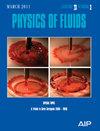Fuzzy uncertainty modeling of generalized Hirota–Satsuma coupled Korteweg–de Vries equation
IF 4.1
2区 工程技术
Q1 MECHANICS
引用次数: 0
Abstract
This article explores the solitary wave solutions of a generalized Hirota–Satsuma Coupled Korteweg–de Vries (HSCKdV) equation. The HSCKdV equation is a mathematical model that describes certain types of long waves, particularly those found in shallow water. The generalized HSCKdV equation is solved exactly using the Homotopy Perturbation Transform Method (HPTM). By applying this technique, the authors obtain solutions in the form of a convergent power series. These solutions offer an understanding of the characteristics of solitary waves within the domain of shallow water waves. The HSCKdV equation has been solved using the adomian decomposition method, and the results have been compared with those obtained from the HPTM. This comparison demonstrates the effectiveness of the HPTM in solving such nonlinear equations. Further, the HSCKdV equation is extended to a fuzzy version considering the initial condition as a fuzzy parameter. Uncertainty in the initial condition is addressed by representing it using triangular and trapezoidal fuzzy numbers. The generalized fuzzy HSCKdV equation is subsequently tackled using the fuzzy HPTM (FHPTM) providing fuzzy bound solutions. Using the FHPTM, we explain the fuzzy results, highlighting how the solitary wave splits into two solitary waves and noting that the lower and upper bound solutions are interchanged due to negative fuzzy results.广义 Hirota-Satsuma 耦合 Korteweg-de Vries 方程的模糊不确定性建模
本文探讨了广义广田-萨摩耦合科特韦格-德弗里斯方程(HSCKdV)的孤波解。HSCKdV 方程是一个数学模型,用于描述某些类型的长波,尤其是浅水中的长波。广义 HSCKdV 方程采用同调钝化变换法 (HPTM) 精确求解。通过应用这一技术,作者获得了收敛幂级数形式的解。这些解法有助于理解浅水波域内孤波的特征。HSCKdV 方程采用阿多米分解法求解,求解结果与 HPTM 得出的结果进行了比较。这一比较证明了 HPTM 在求解此类非线性方程时的有效性。此外,考虑到初始条件是一个模糊参数,HSCKdV 方程被扩展为模糊版本。初始条件的不确定性通过使用三角形和梯形模糊数来表示。随后,利用提供模糊约束解的模糊 HPTM(FHPTM)来处理广义模糊 HSCKdV 方程。利用 FHPTM,我们解释了模糊结果,强调了孤波如何分裂成两个孤波,并指出由于负模糊结果,下界解和上界解发生了互换。
本文章由计算机程序翻译,如有差异,请以英文原文为准。
求助全文
约1分钟内获得全文
求助全文
来源期刊

Physics of Fluids
物理-力学
CiteScore
6.50
自引率
41.30%
发文量
2063
审稿时长
2.6 months
期刊介绍:
Physics of Fluids (PoF) is a preeminent journal devoted to publishing original theoretical, computational, and experimental contributions to the understanding of the dynamics of gases, liquids, and complex or multiphase fluids. Topics published in PoF are diverse and reflect the most important subjects in fluid dynamics, including, but not limited to:
-Acoustics
-Aerospace and aeronautical flow
-Astrophysical flow
-Biofluid mechanics
-Cavitation and cavitating flows
-Combustion flows
-Complex fluids
-Compressible flow
-Computational fluid dynamics
-Contact lines
-Continuum mechanics
-Convection
-Cryogenic flow
-Droplets
-Electrical and magnetic effects in fluid flow
-Foam, bubble, and film mechanics
-Flow control
-Flow instability and transition
-Flow orientation and anisotropy
-Flows with other transport phenomena
-Flows with complex boundary conditions
-Flow visualization
-Fluid mechanics
-Fluid physical properties
-Fluid–structure interactions
-Free surface flows
-Geophysical flow
-Interfacial flow
-Knudsen flow
-Laminar flow
-Liquid crystals
-Mathematics of fluids
-Micro- and nanofluid mechanics
-Mixing
-Molecular theory
-Nanofluidics
-Particulate, multiphase, and granular flow
-Processing flows
-Relativistic fluid mechanics
-Rotating flows
-Shock wave phenomena
-Soft matter
-Stratified flows
-Supercritical fluids
-Superfluidity
-Thermodynamics of flow systems
-Transonic flow
-Turbulent flow
-Viscous and non-Newtonian flow
-Viscoelasticity
-Vortex dynamics
-Waves
 求助内容:
求助内容: 应助结果提醒方式:
应助结果提醒方式:


